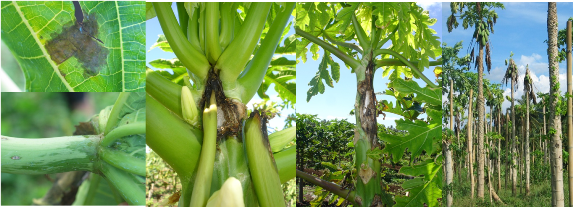 Bacterial crown rot (BCR) has infiltrated the Philippine papaya industry. On its onset, it spoils an entire papaya plantation, wiping out at least 50% of the trees. This translates to production losses of up to US$ 10M per year, equivalent to 20% of the total papaya production (ACIAR HORT/2012/113). Rapidly, a thriving business collapses; investments drain out; and smallholder farmers lose. This creates instability in the livelihoods of farmers, not to mention its corresponding adverse effects on food security. From a macro perspective, this could signal a reduction in the domestic supply of papaya or even a decline in the country’s export earnings from the commodity.
Bacterial crown rot (BCR) has infiltrated the Philippine papaya industry. On its onset, it spoils an entire papaya plantation, wiping out at least 50% of the trees. This translates to production losses of up to US$ 10M per year, equivalent to 20% of the total papaya production (ACIAR HORT/2012/113). Rapidly, a thriving business collapses; investments drain out; and smallholder farmers lose. This creates instability in the livelihoods of farmers, not to mention its corresponding adverse effects on food security. From a macro perspective, this could signal a reduction in the domestic supply of papaya or even a decline in the country’s export earnings from the commodity.
Bacterial crown rot, also called bacterial canker or bacterial decline, is one of the most important diseases of papaya in the Philippines. Once infected, the plant’s stem and other growing points would rot, wilt, and eventually collapse; its leaves, flowers, and petioles lose their vibrance as they fade and brown. Stench from the rotting of plant tissues would soon linger in the infected area.
Papaya in the Philippines is commonly grown in small farms of 1 to 5 hectares with productivity period of 3 to 4 years. From 2011 to 2015, the country produced an average of 16,000 metric tons of papaya, but the looming effects of BCR can cripple the growth of the papaya industry especially in the poor regions of South Cotabato and Bukidnon in Mindanao.
Recognizing the damages BCR brings, a team of experts is conducting the project Integrated disease management strategies for the productive, profitable and sustainable production of high quality papaya fruit in the southern Philippines and Australia. The experts are from the University of the Philippines Los Baños (UPLB) and the Davao National Crop Research, Development and Production Support Center (DNCRDPSC) and are working in collaboration with the Australian Centre for International Agricultural Research (ACIAR) and the Philippine Council for Agriculture, Aquatic and Natural Resources Research and Development of the Department of Science and Technology (DOST-PCAARRD).
The Papaya Integrated Disease Management (IDM) Project is part of the ACIAR-DOST-PCAARRD collaborative Horticulture Program, which focuses on selected fruits and vegetables to improve food security and livelihoods of smallholder farmers.
In essence, the Project team seeks to identify what causes BCR and its survival, how it is transmitted, and how it can be controlled or managed. Information learned through the Project will be packaged as part of the IDM strategies. The Project will work with Del Monte, Sumifru, and the Tupi Papaya Growers Association of South Cotabato for extension and dissemination of the knowledge and technologies developed.
Through the Project, the species associated with BCR has been successfully identified, an important achievement since determining the causal organism of BCR is vital in disease diagnosis and in developing management practices.
Initial trials showed that the BCR pathogen is neither seed-borne nor soil transmissible, but red spider mites appear to transmit BCR to healthy plants after being exposed to infected ones. Further trials will be conducted to confirm and supplement research on disease transmission.
The team is also screening papaya germplasm in the Philippines to find lines tolerant or resistant to BCR. From this study, it was observed that BCR-infected trees showed regrowth of the stem. This discovery will help identify papaya selections that are tolerant to BCR.
Field trials to develop Integrated Pest Management-based strategies to manage BCR will be implemented at the DNCRDPSC once environmental conditions become suitable for the tests.
Implementation of IDM strategies is expected to generate benefits other than preventing the spread of BCR. The management practices being developed will strengthen farmer-researcher partnerships as communication and trust are enhanced. The conventional BCR management practice of applying copper-based fungicides poses health risk to farmers and contributes to soil, water, and air pollution; its potential harm to farmer health and the environment, coupled with its low effectiveness in managing BCR, calls for a better alternative which can be developed through the Project.
The Project envisions producing a management strategy that will reduce the overall impact of BCR disease by 40% through yield increase, cost reduction, and environmental sustainability. Revenues of smallholder papaya farmers are expected to rise as a result. Employment opportunities for rural workers will spring from larger landholders expanding their production.
Ultimately, winning the BCR battle through integrated disease management will improve food security and livelihoods for smallholder papaya farmers.
